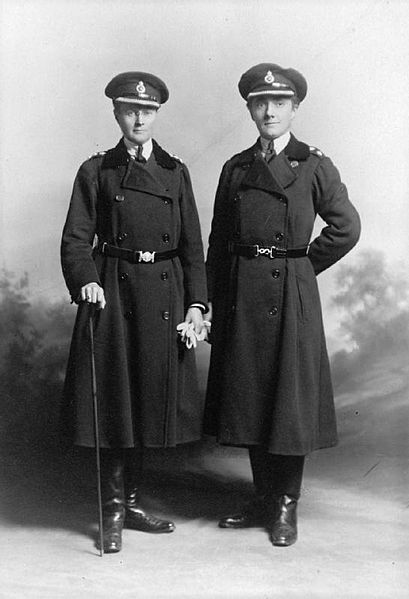Flemish and Saxon refugees gave rise to competitive prostitution, female factory workers and a female police force with fascist leanings. Fri 27 May 2022

Working girls: commandant Margaret Damer Dawson left; subcommandant Mary Sophia Allen right. Source
From Obituary: Miss Margaret Mary Damer-Dawson OBE (1863-1920):
she protected ‘khaki-mad’ young women from themselves, and she protected country-bred, ignorant young men, brought into big camps and great cities from harpies of all kinds. But especially was she the young woman’s friend. She was not of those who believed that it was only a young man who could sow his wild oats and then go straight; she believed that the young woman could pull herself together equally well, and she was entirely opposed to those who seem to think that sack-cloth and ashes and laundry work are the only possible means of redemption for a girl who has decided to give up a bad life.
Many girls who had strayed into the West End, had become known to the police, and had then tired of their life and wished to reform, found in her a useful and sincere friend. She had a gift for finding jobs for many protegees and girls who came to her, knowing her practical sympathy, rarely failed to make good.

Preparing shells for their explosive filling, Chilwell, Nottinghamshire, 1917. Source
From A London Inheritance:
One of her motivations for founding the Women Police Service was her shock in discovering in 1914 that Belgian refugees from the Germans were being enticed into the sex trade by pimps and gangsters, often as they arrived as London’s train stations.
"Ma's cold dead 14 years." Source: Strange Empire
Margaret and Mary weren't alone in their fight for women's rights. From Bourne, Lincolnshire, came Lilian Wyles (1885-1975):
a major influence in the acceptance of women into the police force. She was the only daughter of the Bourne brewer, Joseph Wyles, and after a spell of duty on the streets of London with the new women patrols to assist young girls at risk, was promoted inspector in 1922,

Lilian Wyles photographed around 1919. Source
And fellow founder Antonina 'Nina' Boyle:
one of the pioneers of women police officers in Britain
From Nina Boyle - Spartacus Educational:
The central role of women police during the war was the policing and protection of women, with a focus on moral welfare work, in the context of widespread anxieties about female promiscuity. Women police patrolled parks, the perimeters of garrisons and other public spaces, separating men and women who were thought to be engaging in immoral or inappropriate behaviour and following suspect couples to prevent illicit sexual encounters. Continuing a practice of the late-nineteenth- and early-twentieth-century moral purity groups, women police also entered public houses and other sites of "ill-repute". By 1916, the WPS were also heavily involved in patrolling and inspecting munitions factories where women were employed, to ensure the moral conduct of the women factory workers.
But from Nina Boyle- Wikipedia:
in February 1915, Boyle split from the [Women Police Volunteers] over the use of the WPV to enforce a curfew on women of so-called 'loose character' near a service base in Grantham.
And what of subcommandant Mary Sophia Allen?
In 1915... Allen was sent to sort out problems in Grantham and Hull. Both towns had army camps and local people were complaining about drunken behaviour and a growth in prostitution.

Mary Sophia Allen photographed in 1922. Source
From Mary Sophia Allen - Wikipedia:
Allen was known as 'Robert' by her close circle of female friends, and she was called 'Sir' by her officers.
Sometimes Britain's early female police officers turn out to have a German connection.
From Florence Mildred White (1873-1957):
Prior to joining the police force she was a teacher of English in Germany. She later returned to England and taught German, Italian and French at a school in Salisbury, Wiltshire, reaching a senior post
And sometimes an enthusiastic German connection.
From Mary Sophia Allen:
In 1922 Allen spent time in Cologne where she trained German women for police work.
Allen was a frequent visitor to Nazi Germany and after meeting Adolf Hitler in 1934 and became one of his most fervent admirers. In a discussion with Hermann Goering she was very pleased when he said that policewomen should wear uniform. Even when on official duties with the Women's Auxiliary Service she wore Nazi style jack-boots.
Personally, I suspect some of the source biographical material cited in this post was created for fun. It may be factual but I suspect not. I've picked it up and evaluated as if factual because it is an example of what can be found in seemingly open data. And because it is funny.
Also, fake biographies may be more important than they look:
It does matter. Source: Westworld
They may give you clues about your real environment.
© All rights reserved. The original author retains ownership and rights.
-
More of Margaret Damer-Dawson's fascinating biography. ↩
More of this investigation:
The Mutant Chimp Gets a Culture
More by tag:
#Cheyne Row, #prostitution